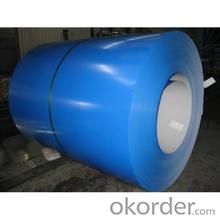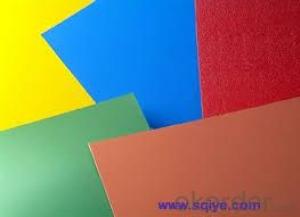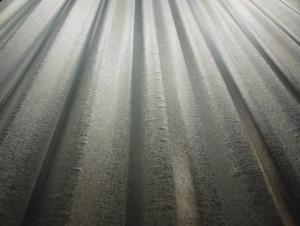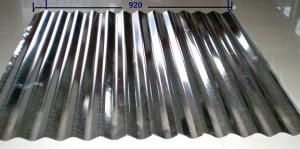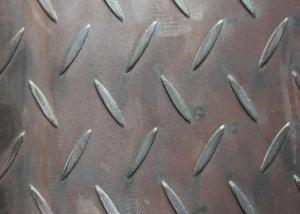Prepainted galvanized corrugated plate / sheet-CGCC
- Loading Port:
- Tianjin
- Payment Terms:
- TT OR LC
- Min Order Qty:
- 30 m.t.
- Supply Capability:
- 500000 m.t./month
OKorder Service Pledge
OKorder Financial Service
You Might Also Like
Specification
1.material :
galvanized steel sheet / prepainted galvanized sheet
2.sheet thickness :
normal use 0.3-0.6mm
3.length:
any length,according to the transportation,generally less than 12m
4.color:
standard color:red,blue,white,grey
special color:according to RAL color
prepainted corrugated steel plate | |
material | galvanized steel sheet |
prepainted galvanized sheet | |
model No. | types of roof sheets |
sheet thickness | normal use 0.3-0.6mm |
length | any length,according to the transportation,generally less than 12m |
color | standard color:red,blue,white,grey |
special color:according to RAL color | |
characteristic | 1:weather proof |
2:heating insulation | |
3:fireproof | |
4:anti-rust | |
5:sound insulation | |
6:long life span:more than 15 years | |
advantages | 1.low foundation cost |
2.easy construction | |
3.time saving | |
4.labor saving | |
application field | 1:construction:prefabricated house,steel house,mobile house,modular house,villa,bungalow design,portable house/carbin,ready made house,kiosk booths,steel building... |
2:container manufacturing | |
3:household appliances and furniture | |
4:vehicle and vessel manufacturing | |
5:others,like machinery structual parts,maufacturing shells of motors and so on | |
packing | plastic film,pallet or as your request |
- Q: How do steel sheets compare to galvanized sheets?
- Steel sheets and galvanized sheets are both made from steel, but they differ in terms of their protective coating. Steel sheets are bare metal sheets, while galvanized sheets have a zinc coating that protects them from corrosion. This zinc coating makes galvanized sheets more durable and resistant to rust and other environmental damages compared to steel sheets.
- Q: Are steel sheets resistant to rust or corrosion?
- Yes, steel sheets are resistant to rust or corrosion due to the presence of protective coatings or alloys that prevent the metal from oxidizing when exposed to moisture or other corrosive elements.
- Q: What are the different types of steel sheet finishes for marine applications?
- Some of the different types of steel sheet finishes for marine applications include hot-dip galvanized, stainless steel, and epoxy coatings.
- Q: Are steel sheets suitable for laser cutting or engraving?
- Yes, steel sheets are suitable for laser cutting or engraving.
- Q: How can steel plates with a thickness of 1MM be welded?
- 1mm steel plate is best made by spot welding or flash welding, for example, electrical welding will cause plate deformation
- Q: Are the steel sheets suitable for architectural cladding?
- Steel sheets are indeed appropriate for architectural cladding. Steel, being a sturdy and long-lasting substance, offers outstanding defense against weather conditions and external influences. It is easily malleable and can be crafted into diverse shapes, making it extremely adaptable for architectural purposes. Moreover, steel cladding provides a contemporary and polished appearance, permitting the creation of visually captivating building exteriors. Additionally, steel sheets can be coated or painted to augment their ability to resist corrosion and to further personalize their look. All in all, due to their strength, durability, versatility, and aesthetic allure, steel sheets are widely favored for architectural cladding.
- Q: What is the average price of a steel sheet?
- Several factors, including size, thickness, quality, and market conditions, can cause the average price of a steel sheet to fluctuate. Typically, steel sheets can be priced anywhere from $500 to $1500 per ton. Nevertheless, it's crucial to bear in mind that prices may vary due to global demand, production costs, and trade policies. Moreover, various suppliers may present different price points, making it wise to compare prices from multiple sources prior to making a purchase decision.
- Q: Can steel sheets be customized in terms of thickness?
- Yes, steel sheets can be customized in terms of thickness. Steel sheets are manufactured in various thicknesses to cater to different applications and requirements. The thickness of a steel sheet can be customized during the manufacturing process according to the specific needs of the customer. This customization allows for versatility and flexibility in using steel sheets for a wide range of purposes, from construction and automotive industries to manufacturing and fabrication processes. Customizing the thickness of steel sheets ensures that they meet the specific strength, durability, and structural requirements of the project at hand.
- Q: Can the steel sheets be easily drilled for fastening purposes?
- Yes, steel sheets can be easily drilled for fastening purposes.
- Q: Can steel sheets be used for conveyor belts?
- Yes, steel sheets can be used for conveyor belts. Steel sheets are often used as the base material for conveyor belts due to their strength, durability, and resistance to high temperatures. They provide excellent support for carrying heavy loads and are commonly found in industries such as mining, automotive, and manufacturing.
Send your message to us
Prepainted galvanized corrugated plate / sheet-CGCC
- Loading Port:
- Tianjin
- Payment Terms:
- TT OR LC
- Min Order Qty:
- 30 m.t.
- Supply Capability:
- 500000 m.t./month
OKorder Service Pledge
OKorder Financial Service
Similar products
Hot products
Hot Searches
Related keywords







